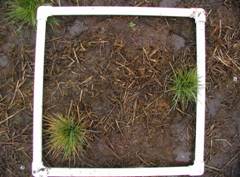Getting Fancy: Sampling Along a Transect
So far we have been working with an imaginary grid covering a back yard, or individual points chosen at random. This was simple enough because the average back yard isn’t all that large and conveniently, it is often in a square-ish shape. However, in some types of vegetation and terrain, grid sampling can be impractical or prohibitively time consuming. For example, the area being sampled might be too large ... or the shape might be irregular ... or there might be obstacles like roads and streams that you would not want to bother sampling. For these reasons, ecologists and field biologists often use transect samples.
The transect is simply a strip of land that runs through the area you're interested in. Transect sampling is very popular because it is a much more convenient way of sampling then trying to cover the entire map (and more convenient means less time spent and thus, research funding saved).
Here are some steps for conducting a simple transect sample:
- Randomly select a starting point in your area of interest (throw a dart at a map, for example).
 From the determined starting point, randomly choose a direction (spin a blindfolded researcher, perhaps).
From the determined starting point, randomly choose a direction (spin a blindfolded researcher, perhaps).- Lay out a transect (using a tape measure or whatever works) from the starting point in the direction you’ve determined. You can decide how long the transect will need to be in order to capture a good representation of what it is you're sampling.
- Determine where along the transect you will collect your sample data. You can choose to sample at some preset point, like maybe every 3 feet along the transect, or you could pick random spots along the transect to sample.
 When you get to your sample spot along the transect, you will need to outline the boundaries of where you're sampling. Laying out a sampling frame is helpful here. This could be as simple as a hula-hoop or something you construct with plastic pipes or drinking straws (ecologists tend not to have a lot of funding, and often do use drinking straws and duct tape). Set down your sampling frame and begin collecting your data from within it.
When you get to your sample spot along the transect, you will need to outline the boundaries of where you're sampling. Laying out a sampling frame is helpful here. This could be as simple as a hula-hoop or something you construct with plastic pipes or drinking straws (ecologists tend not to have a lot of funding, and often do use drinking straws and duct tape). Set down your sampling frame and begin collecting your data from within it.
Transect sampling is similar to the random sampling we did for dandelions, except that the sampling is confined to a single strip of land. Another benefit to transect sampling is that you can come back and resample the same transect week after week or year after year. This is extremely helpful if you are interested in how things change over time, such as how forest succession progresses after a fire.
One hint about transects over time, though -- make sure you mark them well. One time (true story) I went back to sample a transect in a stream and found the general area covered by a 4 foot high sand bar that hadn't been there the week before. A flood had come through and dropped all that sand, and short of a metal detector, I wasn't likely to find the stake marking the transect, or the $100 electronic thermometer attached to it!
Copyright University of Maryland, 2007
You may link to this site for educational purposes.
Please do not copy without permission
requests/questions/feedback email: mathbench@umd.edu